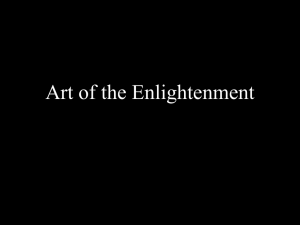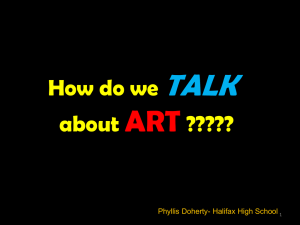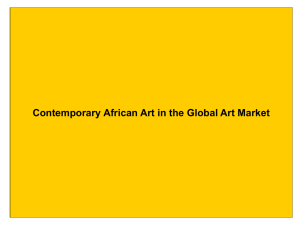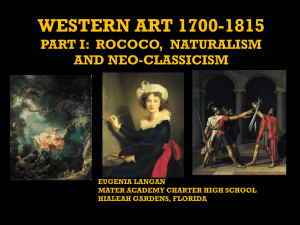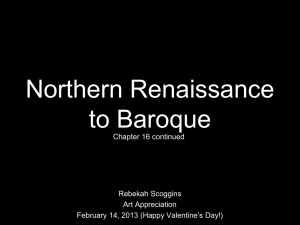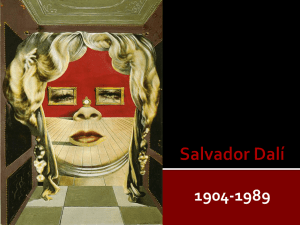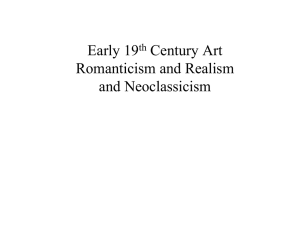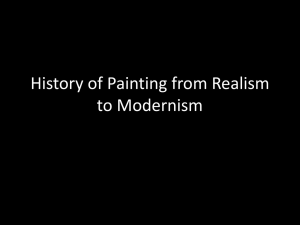1836 Oil on Canvas - Moorestown AP Art History
advertisement
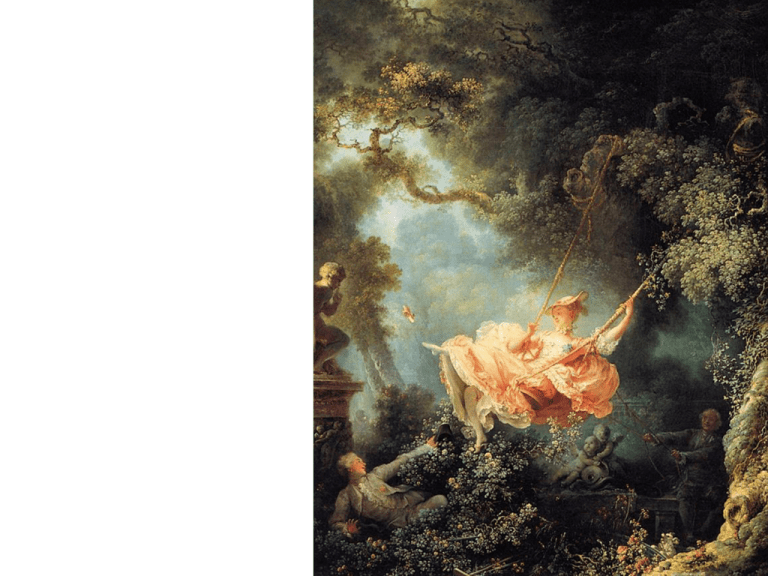
The Swing Jean-Honore Fragonard c.1766 Oil on Canvas Rococo -Known for showing scenes of leisure Elisabeth Louise VigeeLebrun Self-Portrait 1790 Oil on Canvas Naturalism/Rococo France -light-hearted smile/dress (Rococo in this way) -Self confident, economically independent, graceful, member of the academy (her true, serious nature is also apparent, giving it a “natural” feel as well) -Painted a picture of Marie Antoinette that won her acclaim William Hogarth Breakfast Scene from Marriage a la Mode 1745 Oil on Canvas Naturalism England -Hogarth was famous for drawing satirical narratives, often created as a series -this is one of 6 -Shows a marriage as it begins to fall apart -woman has just spent the previous evening playing cards/making music -man has just spent the night doing suspicious activities (see the woman’s bonnet the dog sniffs in his pocket) -accountant raises his hand to heaven as he holds unpaid bills -Religious paintings in background hang next to a curtained ‘erotic’ painting -Copied often in England Thomas Gainsborough Mrs. Richard Brinsley Sheridan 1787 Oil on Canvas Grand Manner Portraiture/Rococo England -Background and dress are misty, feathery, pastel-like (Rococo) -Grand Manner Portraiture: elevated subject with refinement and elegance -large scale figure -controlled contained poses -landscape setting -low horizon line Benjamin West The Death of General Wolfe 1771 Oil on Canvas Naturalism America - ”Death in battle of a young military hero” theme -Mortally wounded English soldier, after defeating the French (to win Canada) -Lighting, composition, and naturalism create high drama and emotions, often seen in paintings of religious martyrs John Singleton Copley Portrait of Paul Revere 1770 Oil on Canvas Naturalism America -NOT like Grand Manner Portraiture -English Portrait Style : DIRECT, PLAIN, CLEAR LIGHTING -pauses while doing an every-day occupation (silversmithing) -same attention to detail on tabletop as on the figure -subtle red lighting reflected on the shadowed side of the figure’s face/hands Jaques-Louis David Oath of the Horatii 1784 Oil on Canvas Neoclassical -It’s a Conflict b/t LOVE and PATRIOTISM -Retold in a popular Parisian Play -STORY: Rome and Alba were at war. Decided to settle it by fighting 3 brothers from each side. One of the Horatti brothers (Rome) was married to the sister of the Alba brothers. One of the Alba brothers was engaged to a sister of the Horatti. -Here, Horatti swear on their swords to fight/die for Rome, oblivious to women crying Jaques-Louis David Death of Marat 1793 Oil on Canvas Neoclassical -Radical Revolutionary / writer / friend of David -Assassinated in 1792 by Charlotte Corday -Shown sitting in his medicine bath (he had a painful skin disease), writing. David included their names. MEANT TO OUTRAGE VIEWERS/FELLOW REVOLUTIONARIES -Cold, empty space above: creates a chilling/oppressive mood -Knife, Wound, letter, made very clear -Pieta position (making him a political martyr) Jaques-Louis David Coronation of Napoleon 1805-1808 Oil on Canvas Neoclassical 20x30” (Louvre) -When Revolutionist party fell, David barely escaped with his life, and jumped at the chance when Napoleon asked him to be his Royal Painter -Shows Napoleon’s Coronation in 1804 -artist included himself -takes place in Notre Dame -wife Josephine being crowned by Napoleon -Pope Pius VII hand is blessing the coronation -Napoleon’s mother present in painting, though she refused to attend Napoleon at the Pesthouse at Jaffe Antoine-Jean Gros 1804 Oil on Canvas -1799 Bubonic plaque hit Romanticism Napoleon is seen fearless and in control (showing his legendary ‘healing’ touch) -Meant to counteract negative publicity about this event (Napoleon ordered all infected people killed) •Neoclassical influence: 3 archways (like Oath of Horatti) Polarized composition (like Oath of Horatti) artist was a student of J.L.David •Romanticism beginnings: exotic (Muslim architecture/attire) death/suffering, emotionalism Grand Odalisque Ingres 1814 Oil on Canvas Romanticism TRANSITIONAL PIECE FROM NEOCLASSICAL TO ROMANTICISM -Traditional pose (Raphael face, reclining nude, mannerist body/elongated limbs, over-the-shoulder gaze taken from J.L.David painting of “Madame Recamier”) -Caused a “stir” because of the exotic elements (woman is a concubine, silk and ornaments are from the near east) Goya The Third of May 1808 1814 Oil on Canvas Romanticism • • • • • • French: Faceless, anonymous Spanish: Horror/Anquish on their faces Arms in crucifixion pose Chiaroscuro Blood stained hill Painted for Ferdinand in 1814 Joseph Mallord William Turner The Slave Ship (Slaves throwing Overboard the dead and dying: Typhoon Coming On) 1840 Oil on Canvas Romanticism/19th Century Seascape -Also of the English Landscape Painter School -Contrast with Constable, in that Turner’s style is more expressive/less delicate -Romantic passion and energy, awe mixed with terror -1783: Slave ship owner realized that his insurance co. would only reimburse him for slaves who died at sea (not those who died of illness en route). So, he had the sick thrown overboard. -style matches the barbaric event -scarlet clouds : blood of the dying - tiny figures against big sun & sky = nature’s power over humans Thomas Cole The Oxbow (View from Mt. Holyoke, Northampton, Massachusetts, after a Thunderstorm) 1836 Oil on Canvas -Hudson River School -Shows us the country’s and the individual’s relationship with the land -Divided composition shows 2 sides of contemporary America (stormy wilderness and tame civilization) -Miniscule Artist, dwarfed by powerful landscape (nature’s power over humans) Gustave Courbet The Stone Breakers 1849 Oil on Canvas Realism -mature man and a younger man breaking stones (lowest laborers of French Society) -dirty browns and grays convey dreary and dismal nature of physical labor -Response to the 1848 French worker rebellion against the bourgeois leaders, demanding better working conditions and more property Honore Daumier Rue Transnonain 1834 Lithograph Realism (philly art museum) •Daumier defended the urban working Class •His art CONFRONTED social Issues and had him put in prison •A civil guard was killed by a sniper during a worker demonstration •The remaining guards stormed the worker’s housing building where the shot came from and killed every inhabitant -This image shows the quiet aftermath of the tragedy -bodies lie about in violent disorder -content of the piece is blunt and true to life (realism) -Similar impact seen in Goya’s Third of May 1808 Edouard Manet Le Dejeuner sur l’Herbe (Luncheon on the Grass) 1863 Oil on Canvas Realism -Manet’s brother Eugene and sculptor Ferdinand Leenhof -Victorine Meurend (Manet’s favorite model) -unidealized figure, looks directly at the viewer without shame or flirtatiousness -foreground is harshly lit while background alludes to traditional painting genres -clear, flat forms made of paint and light, rather than line, acknowledge a painting’s properties (such as the flatness of a painting surface) Edouard Manet Olympia 1863 Oil on canvas Realism -Olympia was a common “professional” name that prostitutes took -looks at the viewer with cool indifference -black maid presents her a bouquet of flowers from a client -artistic style shows abrupt shifts in tonality, as compared to traditional painting -A critic’s response: “This ‘Olympia’ is a courtesan with dirty hands and wrinkled feet … her body has the livid tint of a cadaver displayed in the morgue; her outlines are drawn in charcoal and her greenish, bloodshot eyes appear to be provoking the public, protected all the while by a hideous Negress.”
